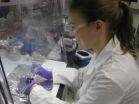(Press-News.org) Suddenly there was a word for chili peppers. Information about archaeological remains of ancient chili peppers in Mexico along with a study of the appearance of words for chili peppers in ancient dialects helped researchers to understand where jalapeños were domesticated and highlight the value of multi-proxy data analysis. Their results are from one (Kraig Kraft et al.) of nine papers presented in a special feature issue of the Proceedings of the National Academy of Sciences on plant and animal domestication edited by Dolores Piperno, staff scientist emerita at the Smithsonian Tropical Research Institute and Curator of South American Archaeology at the National Museum of Natural History and Greger Larson of Durham University in England.
Humans evolved about 200,000 years ago. We spent 95 percent of human history as hunter-gatherers. Why did agriculture begin to emerge in human cultures about 12,000 years ago? Was it the result of a prime mover: divine inspiration, environmental change or population growth? What cultural and natural processes led to the domesticated species that supply most of the world's foods today? The complexity of these questions requires multidisciplinary research. Bringing together scientists from a wide range of disciplines involved in domestication studies, Larson and Piperno organized a meeting funded and hosted by the National Evolutionary Synthesis Centre in 2011. The PNAS special feature is a result of the meeting.
"Having archaeologists and geneticists talking to and collaborating with each other and a suite of new techniques to play with is radically changing the way we think about domestication," said Piperno.
The overview paper (Larson and Piperno et al.) that introduces the special issue emphasizes the need to use both archaeological and genetic evidence to sort out the unique processes of domestication that occurred at about the same time around the world from "predomestication cultivation"—plants cultivated over many generations that still have features of wild plants—and the presence of animals in association with humans to truly domesticated organisms that exhibit very specific traits like large seeds, bigger flowers, reduction in physical and chemical defenses in plants and altered coat color, floppy ears and baby faces (facial neotony) in animals.
Papers in the special feature cover both older and more recent issues in the study of domestication. New genetic screening techniques and the ability to sequence DNA from ancient specimens led Greger Larson and his group at Durham University (Linus Flink et al.) to caution that using modern genetic data alone to guess which genes may have been involved in domestication origins may be misleading. They compared DNA from 80 chickens excavated from 12 different archaeological sites in Europe dated from 280 BC to the 18th Century to modern chicken DNA. Sequencing revealed that yellow-skinned chickens were probably not common early in the domestication process. Their work suggests that yellow skin became the norm only about 500 years ago, probably as a result of global commerce.
Addressing a long-debated question—why hunters and gatherers became farmers—Gremillion, Barton, and Piperno review theories and explanations for agricultural origins, making the case that evolutionary approaches are essential because they offer coherent, empirically testable reconstructions of human behavior.
The authors of the overview paper (Larson and Piperno et al.) expect more exciting results as researchers from around the world and from many disciplines work together to nail down the environmental and ecological contexts of domestication and the shift from hunting and gathering to cultivation and herding. As they say in the paper abstract: "It is difficult to overstate the cultural and biological impacts that the domestication of plants and animals has had on our species. … the next decade will yield even more substantial insights not only into how domestication took place, but also when and where it did, and where and why it did not."
INFORMATION:
The Smithsonian Tropical Research Institute, headquartered in Panama City, Panama, is a unit of the Smithsonian Institution. The Institute furthers the understanding of tropical nature and its importance to human welfare, trains students to conduct research in the tropics and promotes conservation by increasing public awareness of the beauty and importance of tropical ecosystems. Website: http://www.stri.si.edu.
Chickens to chili peppers
Scientists search for the first genetic engineers
2014-04-18
ELSE PRESS RELEASES FROM THIS DATE:
Novel marker discovered for stem cells derived from human umbilical cord blood
2014-04-17
New Rochelle, NY, April 17, 2014—The development of stem cell therapies to cure a variety of diseases depends on the ability to characterize stem cell populations based on cell surface markers. Researchers from the Finnish Red Cross have discovered a new marker that is highly expressed in a type of stem cells derived from human umbilical cord blood, which they describe in an article in BioResearch Open Access, a peer-reviewed journal from Mary Ann Liebert, Inc., publishers. The article is available free on the BioResearch Open Access website.
Heli Suila and colleagues, ...
Five anthropogenic factors that will radically alter northern forests in 50 years
2014-04-17
COLUMBIA, Mo. April 17 – In the most densely forested and most densely populated quadrant of the United States, forests reflect two centuries of human needs, values and practices. Disturbances associated with those needs, such as logging and clearing forests for agriculture and development, have set the stage for management issues of considerable concern today, a U.S. Forest Service study reports.
The report – Five anthropogenic factors that will radically alter forest conditions and management needs in the Northern United States – was published recently by the journal ...
CU researchers discover target for treating dengue fever
2014-04-17
AURORA, Colo. (April 17, 2014) – Two recent papers by a University of Colorado School of Medicine researcher and colleagues may help scientists develop treatments or vaccines for Dengue fever, West Nile virus, Yellow fever, Japanese encephalitis and other disease-causing flaviviruses.
Jeffrey S. Kieft, PhD, associate professor of biochemistry and molecular genetics at the School of Medicine and an early career scientist with the Howard Hughes Medical Institute, and colleagues recently published articles in the scholarly journals eLife and Science that explain how flaviviruses ...
Vitamin B3 might have been made in space, delivered to Earth by meteorites
2014-04-17
Ancient Earth might have had an extraterrestrial supply of vitamin B3 delivered by carbon-rich meteorites, according to a new analysis by NASA-funded researchers. The result supports a theory that the origin of life may have been assisted by a supply of key molecules created in space and brought to Earth by comet and meteor impacts.
"It is always difficult to put a value on the connection between meteorites and the origin of life; for example, earlier work has shown that vitamin B3 could have been produced non-biologically on ancient Earth, but it's possible that an added ...
Bright points in sun's atmosphere mark patterns deep in its interior
2014-04-17
Like a balloon bobbing along in the air while tied to a child's hand, a tracer has been found in the sun's atmosphere to help track the flow of material coursing underneath the sun's surface.
New research that uses data from NASA's Solar Dynamics Observatory, or SDO, to track bright points in the solar atmosphere and magnetic signatures on the sun's surface offers a way to probe the star's depths faster than ever before. The technique opens the door for near real-time mapping of the sun's roiling interior – movement that affects a wide range of events on the sun from ...
Lab researcher discovers the green in Greenland
2014-04-17
At one point in history, Greenland was actually green and not a country covered in ice.
An international team of researchers, including a scientist from Lawrence Livermore National Laboratory, has discovered that ancient dirt in Greenland was cryogenically frozen for millions of years under nearly two miles of ice.
More than 2.5 million years ago. Greenland looked like the green Alaskan tundra, before it was covered by the second largest body of ice on Earth.
The ancient dirt under the Greenland ice sheet helps to unravel an important mystery surrounding climate change: ...
Multitarget TB drug could treat other diseases, evade resistance
2014-04-17
CHAMPAIGN, Ill. — A drug under clinical trials to treat tuberculosis could be the basis for a class of broad-spectrum drugs that act against various bacteria, fungal infections and parasites, yet evade resistance, according to a study by University of Illinois chemists and collaborators.
Led by U. of I. chemistry professor Eric Oldfield, the team determined the different ways the drug SQ109 attacks the tuberculosis bacterium, how the drug can be tweaked to target other pathogens from yeast to malaria – and how targeting multiple pathways reduces the probability of pathogens ...
Study recalculates costs of combination vaccines
2014-04-17
CHAMPAIGN, Ill. — One of the most popular vaccine brands for children may not be the most cost-effective choice. And doctors may be overlooking some cost factors when choosing vaccines, driving the market toward what is actually a more expensive option, according to a new study by University of Illinois researchers.
"The choice of vaccines to administer can be driven by numerous factors," says Sheldon H. Jacobson, a co-author of the study and a professor of computer science and of mathematics at the U. of I. "In an environment where vaccines are under growing public scrutiny, ...
Feinstein Institute researcher publishes new perspective on sepsis
2014-04-17
MANHASSET, NY – In a review published in the April issue of Immunity, Kevin J. Tracey, MD, president of The Feinstein Institute for Medical Research, says it's time to take a fresh look at the medical community's approach to treating sepsis, which kills millions worldwide every year, including more than 200,000 Americans.
Sepsis occurs when molecules released into the bloodstream to fight an injury or infection trigger inflammation throughout the body. Inflammation is necessary for maintaining good health – without inflammation, wounds and infections would never be ...
McCullers reviews influenza, bacterial superinfections in Nature Reviews Microbiology
2014-04-17
Le Bonheur Children's Hospital Pediatrician-in-Chief Jon McCullers, MD, was recently invited to submit a review in the April issue of Nature Reviews Microbiology, one of the world's foremost scientific publications. Dr. McCullers, a world-renowned infectious disease specialist, and chair of the Department of Pediatrics at the University of Tennessee Health Science Center, analyzed the epidemiology and microbiology of co-infections during the 1918, 1957 and 1968 pandemics, as well as more recent 2009 novel H1N1 pandemic.
He reviewed the co-pathogenesis of influenza viruses ...
LAST 30 PRESS RELEASES:
Numbers in our sights affect how we perceive space
SIMJ announces global collaborative book project in commemoration of its 75th anniversary
Air pollution exposure and birth weight
Obstructive sleep apnea risk and mental health conditions among older adults
How talking slows eye movements behind the wheel
The Ceramic Society of Japan’s Oxoate Ceramics Research Association launches new international book project
Heart-brain connection: international study reveals the role of the vagus nerve in keeping the heart young
Researchers identify Rb1 as a predictive biomarker for a new therapeutic strategy in some breast cancers
Survey reveals ethical gaps slowing AI adoption in pediatric surgery
Stimulant ADHD medications work differently than thought
AI overestimates how smart people are, according to HSE economists
HSE researchers create genome-wide map of quadruplexes
Scientists boost cell "powerhouses" to burn more calories
Automatic label checking: The missing step in making reliable medical AI
Low daily alcohol intake linked to 50% heightened mouth cancer risk in India
American Meteorological Society announces Rick Spinrad as 2026 President-Elect
Biomass-based carbon capture spotlighted in newly released global climate webinar recording
Illuminating invisible nano pollutants: advanced bioimaging tracks the full journey of emerging nanoscale contaminants in living systems
How does age affect recovery from spinal cord injury?
Novel AI tool offers prognosis for patients with head and neck cancer
Fathers’ microplastic exposure tied to their children’s metabolic problems
Research validates laboratory model for studying high-grade serous ovarian cancer
SIR 2026 delivers transformative breakthroughs in minimally invasive medicine to improve patient care
Stem Cell Reports most downloaded papers of 2025 highlight the breadth and impact of stem cell research
Oxford-led study estimates NHS spends around 3% of its primary and secondary care budget on the health impacts of heat and cold in England
A researcher’s long quest leads to a smart composite breakthrough
Urban wild bees act as “microbial sensors” of city health.
New study finds where you live affects recovery after a hip fracture
Forecasting the impact of fully automated vehicle adoption on US road traffic injuries
Alcohol-related hospitalizations from 2016 to 2022
[Press-News.org] Chickens to chili peppersScientists search for the first genetic engineers





